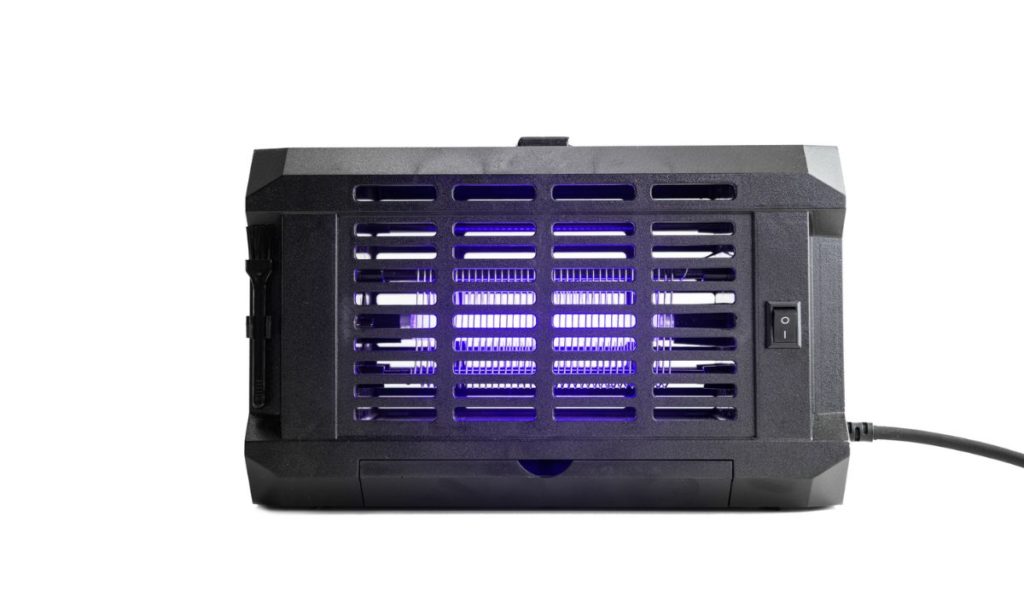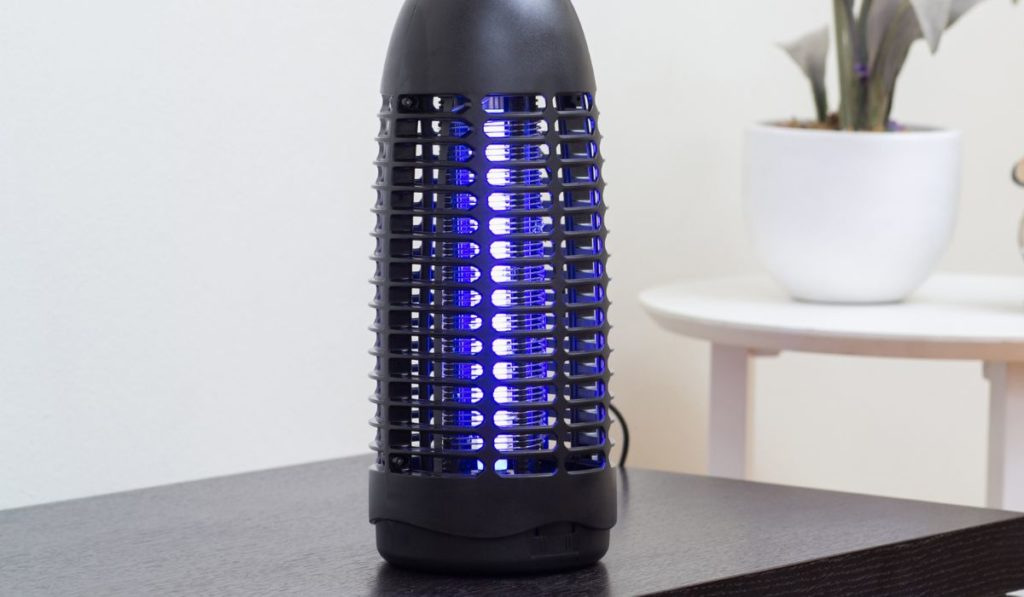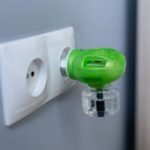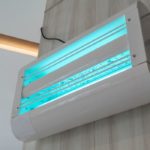When it comes to dealing with pesky mosquitoes, zappers are some of the most useful and effective tools out there. But finding one that suits your needs and particular environment is easier said than done.
When buying a mosquito zapper, it’s important to first decide whether you need it for indoor or outdoor use. You’ll also want to consider how loud and bright the zapper is, what it costs, and whether it requires a power outlet nearby. Most zappers cost between $40 and $100.
The mosquito zapper options can seem endless. So let’s start with the basics and help you determine which kind of mosquito zapper will be ideal for you. Say goodbye to those itchy bites!
What Is a Mosquito Zapper?

Mosquito zappers are actually very simple devices. Basically, they take advantage of how mosquitoes seek their prey: Mosquitoes track warm blooded animals by searching for both body heat and certain frequencies of UV light.
Mosquito zappers give off both heat and a hypnotic frequency of UV light in order to draw in mosquitoes. Once the mosquitoes are drawn in, they are quickly shocked by an electric current, hence the name “mosquito zapper.”
Most mosquito zappers have a cage-like design that features a hook on top so you can hang them somewhere high up. The actual cage is to protect you and others from the electric coils in the center of the zapper — so that you can’t accidentally shock yourselves.
This is only the basic design of a mosquito zapper. Some mosquito zappers employ other mosquito-drawing methods like smells, carbon dioxide, or even fans to literally blow the mosquitoes into the zapper.
Are Mosquito Zappers Effective?
The basic answer to this is yes. Mosquito zappers do have the potential to help rid an area of not only mosquitoes, but also other flying insects as well. However, this is only if you use them properly.
The main thing you need to consider when using a mosquito zapper is proper placement. Think about it — if you place your mosquito zapper in a place where mosquitoes won’t go, it won’t be zapping much of anything!
One of the simplest, but most important things to think about is other sources of light in the area. If you place your mosquito zapper right next to a bright light bulb, many of the mosquitoes might go for the light bulb rather than the mosquito zapper. When using a mosquito zapper, make sure the zapper is the most alluring light source in the area.
Another important thing to think about is wind direction. If you place your mosquito zapper in a place where the mosquitoes have to fly against the wind to get to it, they’ll likely end up having a harder time actually making it to the zapper.
Always make sure to place your mosquito zapper downwind; that way, the mosquitoes don’t have a hard time reaching it. If you don’t want to have to think about wind direction, you can also set up a fan that blows towards the mosquito zapper, effectively changing the wind direction in favor of your mosquito zapper.
What to Consider Before Buying a Mosquito Zapper
There are many important things to consider when buying your mosquito zapper. First of all, you want to consider your price range. The cheapest mosquito zapper is going to be around $40, but it likely won’t be nearly as effective as the $100 mosquito zapper.
Another important thing to consider is aesthetics. Getting a bug zapper that doesn’t look like a metal death cage in the middle of your living room may be important to some people. Bug zappers that don’t look like this tend to cost more though, so it’s yet another aspect to weigh.
You may also want to consider looking into natural mosquito traps if chemicals and electricity bother you. There are plenty of traps that you can make at home that work fine at catching mosquitoes, although they are usually worse than mosquito zappers.
The Best Mosquito Zappers on the Market
There are tons of different mosquito zappers out there, and it can be a little overwhelming to decide which one is right for you. Which one you should get depends on a number of factors, such as whether you need it for indoor or outdoor use, and how big your budget is.
Let’s go through a few of the top mosquito zappers to help you determine which one is the right one for the job.
Flowtron BK-40D Electronic Insect Killer
The Flowtron BK-40D Electronic Insect Killer is made specifically for outdoor use. It has a high intensity light bulb that can draw mosquitoes from up to one acre away. The Flowtron BK-40D is also relatively cheap. You can find it here on Amazon for around $50-$60. It’s also worth noting that the BK-40D doesn’t only draw mosquitoes, but also any flying insects within its radius.
Most importantly, the Flowtron BK-40D doesn’t rely on light alone. It also comes with a cartridge of octenol. Octenol is an active ingredient in most pesticides, and it works to further increase the number of mosquitoes lured in by the device. These octenol cartridges last for around 30 days of use, and replacement cartridges can be found here (on Amazon).
There are a couple of downsides to the Flowtron BK-40D. First, the Flowtron BK-40D is much brighter and louder than its competitors. It attempts to make up for this with its almost excessive range, but this may be a deal breaker for people who want a mosquito zapper that won’t distract them from their relaxation.
The second issue is that the power cord for the Flowtron BK-40D is pretty short, meaning you’ll likely need an extension cord to plug it in. If you’re willing to overlook these two flaws, this is one of the most effective outdoor mosquito zappers out there.
Aspectek 40W Electric Indoor Insect Killer
As the name suggests, the Aspectek 40W Electric Indoor Insect Killer is designed specifically to rid you of an indoor bug problem. This one has a very classic looking design, appearing more like a screen than a bug zapper.
The Aspectek 40W boasts that it can rid you of houseflies, mosquitoes, moths, and even wasps. It’s also around the same price as the Flowtron BK-40D. You can get it here on Amazon for around $60.
The Aspectek 40W uses two UV lamp bulbs protected by an electric shock barrier to lure in insects and then zap them. These bulbs have a very impressive lifetime of around 5,000 hours of use. The Aspectek 40W also features a protective guard to prevent people or pets from touching the electric part.
The best part about the Aspectek 40W is that it’s extremely easy to clean. It features a drawer at the bottom that any bugs will fall into after being shocked. You can remove this drawer and then scrape the bugs into the trash without ever having to touch them.
However, the Aspectek 40W also falls victim to being overly loud and bright. It’s recommended that you put it somewhere out of the way so that it’s not overly distracting. You can also limit its use to certain times of the day.
If you can get past the few downsides, the Aspectek 40W is one of the best indoor bug zappers out there.
DynaTrap DT1050-AZSR Mosquito & Insect Trap
This option is great for people that want a mosquito zapper that works silently. The DynaTrap DT1050 is pretty much the Swiss army knife of mosquito traps. It can be used both indoors and outdoors, and it uses something the manufacturer refers to as “3-way protection.”
First, the mosquitoes are lured by the UV light, then they’re lured in by the carbon dioxide that the DynaTrap DT1050 gives off, and, finally, a silent fan sucks them into the trap.
The DynaTrap DT1050 gets away with being whisper quiet because it doesn’t actually zap the mosquitoes. It simply traps them inside until they die, so you don’t have to worry about constant shock sounds. It’s also extremely easy to clean.
It has a collection tray at the bottom that you can simply remove and empty. Because the Dynatrap uses carbon dioxide, which is toxic to humans and animals if inhaled in large amounts, it’s recommended that you place the trap about 20-40 feet away from any people and leave a window open for ventilation while the trap is on.
The main problem with the DynaTrap DT1050 is the cost. The DynaTrap DT1050 will run you somewhere between $80 and $150. If whisper quiet mosquito removal is important to you, the price is very much worth it. The DynaTrap DT1050 can be found here (on Amazon).
Are Mosquito Zappers Safe for Pets?

Yes, most mosquito zappers are perfectly safe for pets. Mosquito zappers usually have a protective cage to keep you from being able to touch the electric parts yourself, which extends to your furry friends as well. However, to be on the safe side, it’s recommended that you put your mosquito zappers somewhere out of reach of your pets.
The main thing you need to be wary of is carbon dioxide mosquito traps. Carbon dioxide can be toxic to both humans and animals if inhaled in large amounts, so definitely keep these away from your pets.
The biggest problem you’ll run into as a pet owner when warding off mosquitoes is bug sprays. Many common bug sprays use a chemical called DEET, which has been found to cause a number of problems in both dogs and cats. However, there are plenty of bug sprays that replace the DEET with natural oils like citronella oil or lemongrass oil.
Mosquito Zappers vs. Other Mosquito-Repelling Devices
Now that we’ve talked about mosquito zappers and how they work, you may be wondering how they compare to other mosquito-repelling methods. Let’s go through a few other mosquito repellant methods and how they fare against the mosquito zapper.
Mosquito Zappers vs. Bug Spray
The choice between mosquito zappers and bug spray comes down to whether you want protection around an area or protection for yourself. This usually depends on how much you’ll be moving. For example, if you’re on a hiking trip, it’s probably a better idea to use a long-lasting bug spray (on Amazon) than to use a mosquito zapper, whereas if you’re just relaxing in your backyard, a mosquito zapper can get the job done.
Some people would recommend using both at the same time. It’s also worth noting that because certain bug sprays are toxic for animals, some people may want to avoid using bug spray when possible.
Mosquito Zappers vs. Paper Traps
This debate comes down to two things: what bugs you want to catch and how much you’re willing to pay. Fly paper is a product that uses pheromones to attract flies who then land on a sticky paper they can’t get off of. Fly paper is capable of catching mosquitoes, but it’s more incidental. The mosquitoes sometimes just happen to fly into the paper. The pheromones are specifically designed to catch house flies.
Usually the bug zapper would be the way to go every time, but if you’re running on a tight budget, fly paper may be more up your alley. You can usually find fly paper (on Amazon) for a few bucks, whereas a good bug zapper will usually be in the ballpark of $50 to $80. Basically, fly paper is much cheaper, but it does a worse job at catching mosquitoes specifically.
Mosquito Zappers vs. Water Traps
One of the most common things that can bring mosquitoes to your yard is the presence of standing water. Mosquitoes look for standing water as this is the best habitat for their larvae to grow and develop. To deal with this issue, it’s recommended that you drain any sources of standing water when not in use. However, sometimes there are things like bird feeders that you can’t just drain.
For this problem, they invented the mosquito dunk (on Amazon). Mosquito dunks are little tablets that dissolve in water and then make the water toxic for mosquito larvae. These dunks aren’t toxic for birds or any other animals.
It’s generally recommended that you use both a mosquito dunk and a mosquito zapper. The mosquito dunk will prevent the mosquitoes from breeding in your yard, and the mosquito zapper will deal with any mosquitoes currently present.
How Else You Can Get Rid of Mosquitoes This Summer
There are ways to protect yourself from mosquitoes that don’t involve buying a complicated contraption as well. Bug spray is a simple but effective option that won’t break your bank. As previously mentioned, many bug sprays contain a chemical called DEET that can be harmful towards pets, but there are also many bug sprays that use natural repellents.
If you want free tips to help protect you from mosquitoes, you could simply cover up as much skin as possible when going outside. Consider wearing a long-sleeve shirt and long pants. You may also want to avoid sitting outside at dusk, as this is when mosquitoes are at their most active.








